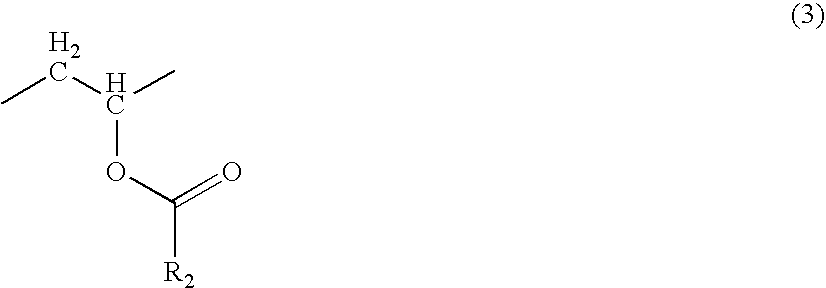Polyvinyl Acetal Resin Varnish Gelling Agent, Nonaqueous Electrolyte Solution, And Electrochemical Device
a technology of polyvinyl acetal resin and resin varnish, which is applied in the manufacture of final products, non-conductive materials with dispersed conductive materials, conductive materials, etc., can solve the problems of high stimulus property, high toxicity to human bodies, and inability to dissolve polyvinyl acetal resin in a sufficiently even manner in a generally-used industrial solvent, etc., to achieve low viscosity, less problem, and high safety
- Summary
- Abstract
- Description
- Claims
- Application Information
AI Technical Summary
Benefits of technology
Problems solved by technology
Method used
Image
Examples
synthesis example 1
Synthesis Example of Polyvinyl Acetal Resin
[0146] Polyvinyl acetate was alkali-saponified into polyvinyl alcohol resin (saponified degree: 89%, mean degree of polymerization: 800). After 25 g of the polyvinyl alcohol, 200 ml of 50% acetate solution, and 40 ml of 10% hydrochloric acid are mixed with each other, 100 ml of formalin (37% formaldehyde solution) was added to a thus-obtained mixture and thus kept under a reaction at 30° C. for five hours. After completion of the reaction, diluted acetic acid was added to the reaction liquid to have a reactant deposited therein, and a deposit was obtained by filtration and neutralized with sodium hydroxide, washed with water, and then dried, resulting in polyvinyl formal. A composition ratio of thus-obtained solid was analyzed on the basis of JIS K6729 “Testing methods for polyvinyl formal”, with the result that the solid was determined as polyvinyl formal resin composed of 82.5% vinyl formal unit (R1=hydrogen atom in the general formula (...
synthesis example 2
Acid Denaturation Example of Polyvinyl Acetal Resin
[0149] The polyvinyl formal resin (of which mean degree of polymerization was 800) obtained in the same manner as the synthesis example 1 was dissolved in a 100 ml mixed solvent containing ethylene carbonate and ethylmethyl carbonate at 2:1 (volume ratio) so that a concentration of the polyvinyl formal resin reached 5%, and 0.01% sulfuric acid was then added to a thus-obtained solvent, followed by heating treatment (acid-denaturizing treatment) at 45° C. for 144 hours, thus resulting in a solution containing an acid-denatured material of the polyvinyl formal resin.
[0150] The fact that the polyvinyl acetal resin had been acid-denatured was determined by a change in concentration of protons appearing at 4.28 ppm in an NMR spectrometer (trade name: JNM-A500 (500 MHz) manufactured by JEOL Ltd.) between a value obtained before the acid-denaturizing treatment and a value obtained after the acid-denaturizing treatment. In the measurement...
synthesis example 3
[0163] A solution containing an acid-denatured material of polyvinyl formal resin was obtained in the same manner as the synthesis example 2 except for the use of polyvinyl formal resin which is different in content ratio of the vinyl formal unit (R1=hydrogen atom in the general formula (1)), the vinyl alcohol unit (2), and the vinyl acetate unit (3) (R2=methyl group in the general formula (3)). A thus-obtained acid-denatured material had properties shown in Table 4. Further, regarding all of the obtained three types of acid-denatured materials except for polyvinyl formal containing 2.8 mol / kg hydroxyl group, the concentrations of protons appearing at 4.28 ppm were 70% or less-decreased by the acid treatment.
PUM
| Property | Measurement | Unit |
|---|---|---|
| water content | aaaaa | aaaaa |
| electromotive force | aaaaa | aaaaa |
| temperature | aaaaa | aaaaa |
Abstract
Description
Claims
Application Information
 Login to View More
Login to View More - R&D
- Intellectual Property
- Life Sciences
- Materials
- Tech Scout
- Unparalleled Data Quality
- Higher Quality Content
- 60% Fewer Hallucinations
Browse by: Latest US Patents, China's latest patents, Technical Efficacy Thesaurus, Application Domain, Technology Topic, Popular Technical Reports.
© 2025 PatSnap. All rights reserved.Legal|Privacy policy|Modern Slavery Act Transparency Statement|Sitemap|About US| Contact US: help@patsnap.com



